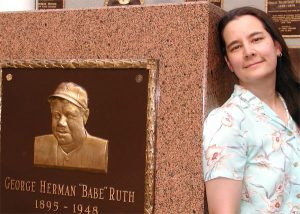Revising Mantle’s Griffith Stadium Home Run
A Case Study in Forensic Physics
Alan Nathan
An intriguing look at one of the most iconic moments in the career of one of baseball’s most iconic figures. Lots has been written about the famous homer, as written about in the book CLOUT by Dan Valenti. The characters: Yankee publicist Red Patterson, Mickey Mantle, and Donald Dunaway. The places: Griffith Stadium and 434 Oakdale Place. But the claim that the homer carried 565 feet has been “debunked” before.
(Nathan shows an overhead shot of the stadium, the street, and the house.)
The undisputed historical facts: Dunaway was a 10 year old kid playing hooky, who ran out of the stadium to get the ball. Patterson also ran out of the stadium, paid the kid for the ball, and paced off the distance to the sign that the ball had glanced on its way out. He came up with 562 feet (later revised to 565 feet) and the whole incident spawned the term “tape measure home run” despite the fact that he didn’t use a tape measure. (Language is wacky that way.)
Previous “debunking” efforts by other SABR members/scholars: Bill Patterson said more likely 515 feet. Physicist Bob Adair said 506 feet.
What is the real likely distance if the ball had not hit the sign and where did it really come down?
What we Know:
460 feet to the sign that was hit.
Sign was 50-60 feet above ground level. We’ll assume 60.
Donald Dunaway got the ball behind the house that faced 5th St. NW (565 feet away).
Wind was blowing steadily out at 20 mph.
What we Don’t know:
batted ball parameters (speed, spin, etc)
how long it took to hit the sign
precise wind speed or direction
precise height of the sign
How do we constrain the trajectory?
Ball hit the sign. BBS batted ball speed and vertical launch angle (VLA) that will allow to hit sign.
Ambiguity would be nearly removed knowing flight time. But we don’t know that. There’s no video or film of the feat.
With a bigger arc, the shorter the distance. The more “pop-uppy” it is. Likewise the more “line-drivey” one goes further. Without knowing the angle or the amount of time it took to get to hit the sign how can we determine? (Nathan shows diagrams of various arcs and projections.)
We need more information.
How about the fact that the ball was retrieved behind the row houses? The ball had to have CLEARED A TWO STORY BUILDING to get to where the boy picked it up. It couldn’t have bounced over, so it had to have cleared on the fly or hit the roof.
Nearest house was 512 feet. Roofs were 22 feet high. As researched by Jane Leavy for her upcoming biography of Mickey Mantle. Turns out that is enough info for us to update the trajectory info.
If the ball at least hit the roof of the house, the VLA has to be less than 31 degrees and the final distance comes to 535 feet as the lower limit, and 542 as an upper limit. And there is still the possibility it could have cleared the roof and gone farther, just no evidence if it did. So the 565 foot claim is actually possible, and we can definitely say that the previous “debunkings” were bunk. 535 at least, and possibly 542 feet.
Is this a credible result? Let’s compare it to a home run hit by Wladimir Balentien in Cincinnati in 2009. Almost identical shown by the Hit Tracker data. So yes, this is a credible result.
Without the wind, probably “only” 460 feet.
For more info: a-nathan@illinois.edu
EDIT: This presentation was given honorable mention by the judges at the end of the conference.


Post a Comment